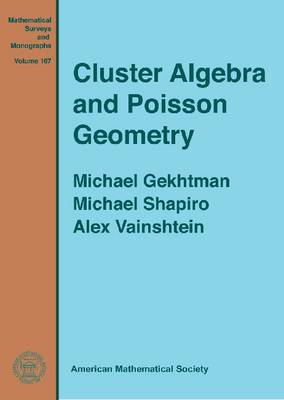Mathematical Surveys and Monographs
1 total work
Cluster Algebra and Poisson Geometry
by Michael Gekhtman, Michael Shapiro, and Alek Vainshtein
Published 1 January 2010
Cluster algebras, introduced by Fomin and Zelevinsky in 2001, are commutative rings with unit and no zero divisors equipped with a distinguished family of generators (cluster variables) grouped in overlapping subsets (clusters) of the same cardinality (the rank of the cluster algebra) connected by exchange relations. Examples of cluster algebras include coordinate rings of many algebraic varieties that play a prominent role in representation theory, invariant theory, the study of total positivity, etc. The theory of cluster algebras has witnessed a spectacular growth, first and foremost due to the many links to a wide range of subjects including representation theory, discrete dynamical systems, Teichmuller theory, and commutative and non-commutative algebraic geometry. This book is the first devoted to cluster algebras. After presenting the necessary introductory material about Poisson geometry and Schubert varieties in the first two chapters, the authors introduce cluster algebras and prove their main properties in Chapter 3. This chapter can be viewed as a primer on the theory of cluster algebras. In the remaining chapters, the emphasis is made on geometric aspects of the cluster algebra theory, in particular on its relations to Poisson geometry and to the theory of integrable systems.|Cluster algebras, introduced by Fomin and Zelevinsky in 2001, are commutative rings with unit and no zero divisors equipped with a distinguished family of generators (cluster variables) grouped in overlapping subsets (clusters) of the same cardinality (the rank of the cluster algebra) connected by exchange relations. Examples of cluster algebras include coordinate rings of many algebraic varieties that play a prominent role in representation theory, invariant theory, the study of total positivity, etc. The theory of cluster algebras has witnessed a spectacular growth, first and foremost due to the many links to a wide range of subjects including representation theory, discrete dynamical systems, Teichmuller theory, and commutative and non-commutative algebraic geometry. This book is the first devoted to cluster algebras. After presenting the necessary introductory material about Poisson geometry and Schubert varieties in the first two chapters, the authors introduce cluster algebras and prove their main properties in Chapter 3. This chapter can be viewed as a primer on the theory of cluster algebras. In the remaining chapters, the emphasis is made on geometric aspects of the cluster algebra theory, in particular on its relations to Poisson geometry and to the theory of integrable systems.
